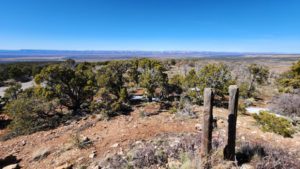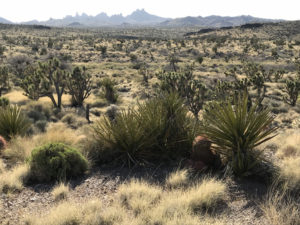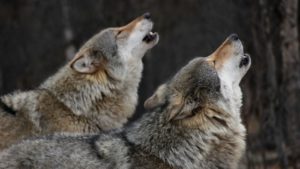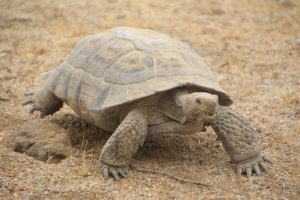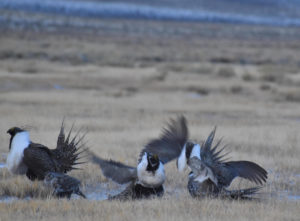FOR IMMEDIATE RELEASE
Contact: Kya Marienfeld, Southern Utah Wilderness Alliance, 435-259-5440, kya@suwa.org
Laura Welp, Western Watersheds Project, 435-899-0204, laura@
Decision finds BLM failed to consider project alternatives that would have limited post-wildfire treatments to native seeds and manual restoration methods
Moab, UT (February 18, 2021) – The U.S. Department of Interior’s Board of Land Appeals (IBLA) yesterday set aside two late-summer 2020 decisions by the Bureau of Land Management’s (BLM’s) Kanab Field Office to chain and seed with non-native livestock forage in two post-fire landscapes within the original boundaries of Grand Staircase-Escalante National Monument.
In overturning BLM’s decisions, the IBLA held that the BLM erred in its rushed National Environmental Policy Act (NEPA) process because it “fail[ed] to consider alternatives that would have limited its post-wildfire treatments to native seeds and to manual methods.” The Southern Utah Wilderness Alliance and Western Watersheds Project had encouraged the BLM to consider a more environmentally-sound alternative treatment plan that would only use native species for seeding and would not use chaining—the most invasive and soil-disturbing method—as part of the agency’s restoration plans.
Unfortunately, although the IBLA held that the BLM’s rushed approval of these projects violated federal law, the agency had already started on-the-ground operations, including chaining and seeding with non-native plant species. All further activities for both projects are prohibited as of yesterday’s IBLA order, and the BLM confirmed earlier today that its heavy equipment is being moved offsite.
“Using natural restoration methods is critical for fragile desert ecosystems, because science shows that introducing vigorous, non-native seed mixes significantly decreases the long-term potential for native species to recolonize,” said Kya Marienfeld, Wildlands Attorney for the Southern Utah Wilderness Alliance. “This is precisely why the 2000 Grand Staircase-Escalante National Monument Management Plan required managers to consider pre-burn conditions before approving post-fire management activities, and required that only native seeds be used in restoration. When Monument protections were removed from these areas by President Trump in 2017 and new management plans approved last year, these science-based prohibitions disappeared. The BLM’s hurried approval of these two ‘fire restoration’ projects is direct evidence of how little it takes to permanently transform a native ecosystem and harm habitat for plants and wildlife without these protections.”
“Trump stripped National Monument status from Wire Pass and Pine Hollow, along the iconic House Rock Valley road,” said Laura Welp, Ecosystem Specialist with Western Watersheds Project and a former Grand Staircase-Escalante National Monument botanist. “When a wildfire occurred there, the BLM took advantage of the reduced protections to destroy pinyon-juniper woodlands and native shrublands with bulldozers hauling massive chains, and to seed non-native plants to benefit livestock.”
The Wire Pass and Pine Hollow wildfires, which occurred in July and August of 2020, collectively burned more than 5,000 acres on the west side of House Rock Valley Road in Kane County, Utah, directly across the road from the Paria Canyon-Vermillion Cliffs Wilderness Area and near access points for the world-renowned geologic feature known as “the Wave.” Following these two lightning-caused fires, the BLM pushed through hurried environmental analyses and approved “restoration plans” in both burn areas to chain burned and remaining live vegetation and aerial seed an almost 4,000 acre area with crested wheatgrass and other persistent and invasive non-native perennial forage species favored by livestock.
The BLM’s plan to introduce non-native species in the name of restoration was particularly alarming given that both burn areas were dominated by a diversity of native species including pinyon pine, sagebrush, and cliffrose prior to the wildfires, and were largely untouched by human-disturbance—an increasingly rare baseline for public lands devastated by grazing, motorized vehicle intrusions, and other human impacts throughout the West.
“This was a tremendously important appeal, and we are pleased with the IBLA’s decision” continued Marienfeld. “We expect to see the original boundaries of Grand Staircase-Escalante National Monument and its full management protections restored soon, preventing these kinds of ill-conceived activities from being proposed or carried out anywhere on the full, 1.9 million-acres of this exceptional and fragile National Monument.”
—-
Additional Resources
Interior Board of Land Appeals Order, February 17, 2021
Lawsuit Launched Over Trump Plan to Accelerate Clearcutting, Herbicide Spraying, Fuel Breaks Across Six Western States (January 13, 2021).
Interior Board Overturns BLM Decision to Replace Native Forests with Livestock Forage in Grand Staircase-Escalante National Monument (September 17, 2019).
Do mechanical vegetation treatments of pinyon-juniper and sagebrush communities work? A review of the literature. 2019. Jones.

